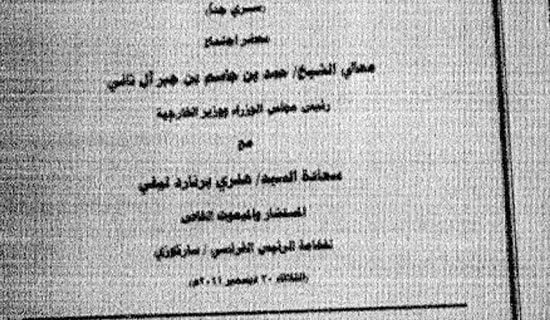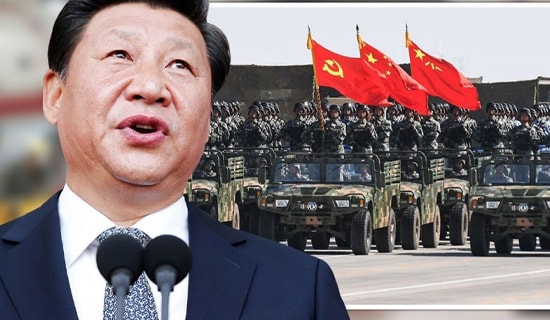Introduction
On February 10, 2018, Iranian forces in Syria sent an Iranian attack drone across the border into Israeli airspace; the drone was downed by an Israeli army helicopter. Israel then bombed the base and the command and control vehicle that had launched the drone, and an Israeli F-16 jet was shot down by antiaircraft fire by Syrian forces and crashed in northern Israel. In response, Israel then bombed 12 Iranian and Syrian targets in Syria, in an operation that the Israeli Air Force second-in-command called "the biggest and most significant attack the Air Force has conducted against Syrian air defenses" since the 1982 Lebanon War.[1]
Iran Changes Its Strategy Vis-à-vis Israel – And Then Immediately Changes It Back
Recently, Iran has stepped up its preparations for a strike on Israel; in December 2017, it was reported that Gen. Qassem Soleimani, commander of the Islamic Revolutionary Guards Corps (IRGC) Qods Force, had spoken directly with Hamas and Islamic Jihad in this matter. There has also been an increase in visits to the Lebanon-Israel border by senior Iranian officials.[2]
Despite this, prior to February 10, 2018, Tehran had not deviated from the main element of its strategy: action by means of proxies everywhere it is involved in the Middle East. However, its February 10 sending of a drone into Israeli airspace constitutes a distinct shift in Iran's strategy, by opening a direct air front against Israel.
One prominent individual serving the Iranian regime, journalist Hossein Dalirian, heads the military desk of the Iranian news agency Tasnim, which is affiliated with the IRGC. He tweeted a summary of the incident, beginning with the drone's incursion into Israeli airspace, and also tweeted a photo of the fragments of the drone after it was downed next to a photo of an undamaged one of the same make and model[3] (for more tweets by Dalirian stating that the drone was Iranian, see Appendix). In his tweet, Dalirian set out the events as follows:
"1. The Iranian drone enters Israeli airspace
"2. [Israeli] Apache helicopter takes off to strike it
"3. At the same time, Israeli fighter jets enter Syrian airspace to strike the drone's control center
"4. The drone is downed
"5. Syrian air defenses shoot down the helicopter and the F-16
"6. Israel [says]: The drone was launched as bait
"#Israel has fallen."

Dalirian's tweet (Twitter.com/HosseinDalirian/status/962233392854130688, February 10, 2018)
Reasons Iran Changed Its Strategy From Using Proxies To Direct Action Against Israel
There are two main reasons why Iran took direct action against Israel at this time:
SUPPORT OUR WORK

1. The Iranian regime wanted to present an accomplishment for its Revolution Day, February 11.
2. The regime wanted to divert the Iranian public's attention to an external enemy (Israel) and to its own strategic achievements as the popular civil anti-regime protests at home continue, even if they are of a more limited scope than last month's.
Immediately After The Drone Incident, Iran Reverts To Proxy Strategy
Only a few hours later, Iranian regime spokesmen began vehemently denying any Iranian involvement in the incident as well as the very existence of the Iranian drone, while reverting to their previous strategy. They also reiterated warnings to Israel to stop its airstrikes in Syria and stressed Iranian Supreme Leader Ali Khamenei's statement that the era of Israeli freedom of action is over. IRGC deputy commander Hossein Salami said, a few hours after the drone incident: "Regarding the Israelis' claim that they struck an Iranian drone on the border between Syria and the occupied lands [i.e. Israel], we are not confirming any Israeli report. We will confirm it [only] if the Syrians confirm it, because the Israelis are liars. We have no military presence in Syria; we are in Syria only in the capacity of military advisors. The presence of the Syrian army is sufficient to defend [Syrian] soil."[4] Another report quoted him as saying: "You know that our Supreme Leader, Imam Khamenei, announced [that] the end of the Zionist regime [would come] within less than 25 years. With God's help, the Islamic ummah is actualizing this reality. Today, the Israelis hear the voices of Muslim children on their border, and are forced to abandon their dream of '[Israel] from the sea to the river.' America imposed sanctions on [Iran], seeking to paralyze us, but we have advanced, and from this position we can now destroy all the American bases in the region and create hell for the Zionists."[5]
Iranian Foreign Ministry spokesman Bahram Qassemi said on February 10: "The claim about an Iranian drone that flew [into Israel] and about Iran's involvement in the downing of the attacking Zionist fighter jet is too ridiculous to address, because Iran's presence in Syria is only in an military advisory capacity, at the behest of the legitimate and legal Syrian government."[6]
On February 11, Iran's Revolution Day, Farzad Esmaili, commander of Khatam Al Anbia, Iran's air defense force, said: "For the past 40 years, Israel's claims have been false. We are an independent country, and any independent country that was attacked would do the same thing that was done to the Israeli F-16 and the Saudi F-15.[7] No independent country remains silent in the face of an attack."[8]
It should be noted that the Iranian spokesmen were careful to say that everything that happened was carried out by Syria, from decision to execution, in order to reconfirm that Iran is adhering to its previous strategy of acting only through proxies, and does not seek to change this to direct confrontation with Israel. Iranian Supreme National Security Council secretary Ali Shamkhani described the incident as follows: "Syria decided to change the unilateral 'hit and run' formula and to precipitate an incident that will be [remembered] forever in the region, which gladdened the Syrian people, who handed out sweets [in celebration]. Here we should congratulate the Syrian people on this [act of] resistance."[9]
Khamenei advisor Ali Akbar Velayati also emphasized that it was Syria that had acted against Israel in response to Israeli attacks, and that absent the Israeli attack, this would not have occured: "The incident [of the downing of the Israeli plane] is a turning point in the fighting history of the Palestinian people. One of the important countries of the resistance axis [Syria] exercised its right to protect its territorial integrity. Had the Israeli planes not attacked, this incident wouldn't have occurred. Israel should think about what it has done. If it wants to carry out another attack like this, [it should keep in mind that] countries have a right to defend their sovereignty. Syria has this right too...
"Iran is present in Syria to help the legitimate Syrian government and the oppressed Syrian people. Without Iran, who knows what would happen to the resistance axis. Iran will continue its presence in Syria to defend the resistance axis, not according to the Zionist regime's interpretation [of where it should be] but according to what Iran and Syria have agreed upon."[10]
Reasons Iran Reverted To Previous Proxy Strategy From Direct Action
In MEMRI's assessment, Iran's retreat from the strategy of direct action was the result of Israeli deterrence and also of the restraining influence of Russia, which, for various reasons, both domestic and global, is not interested in an all-out Israel-Iran confrontation in a region under its auspices – i.e. Syria.
*A. Savyon is Director of the MEMRI Iran Media Project; U. Kafash is a Research Fellow at MEMRI.
Appendix: Tweets About The Drone By Tasnim Military Desk Director Hossein Dalirian
On February 10, Dalirian tweeted the following:[11]
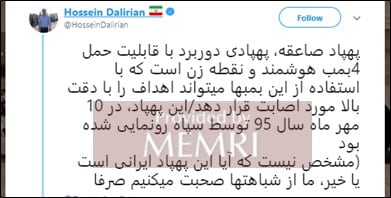
"The Saegheh is a long-range drone capable of carrying four accurate smart bombs. These bombs can strike targets with great precision from above. The drone was first presented on October 1, 2016 (It is not clear whether the drone [downed by Israel] is Iranian, I am merely talking about the similarities [between the two]." Twitter.com/HosseinDalirian/status/962304677122539520

"Iran has yet to say whether or not the drone was Iranian. But the Saegheh is a jet drone, and a bomber. (In the photo: the drone downed this morning by Israel is a jet and very similar to the Saegheh)." Twitter.com/HosseinDalirian/status/962306884014346240
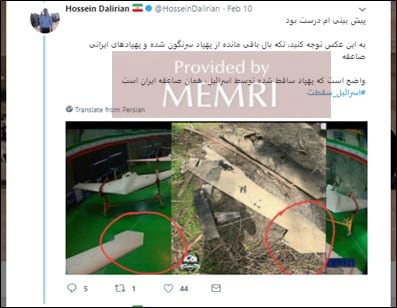
"My assessment was correct. Note this photo [showing] part of the wing from the wreckage of the downed drone, alongside the Iranian Saegheh drone. The drone downed by Israel is clearly an Iranian Saegheh drone. #Israel has fallen" Twitter.com/HosseinDalirian/status/962398606136356866
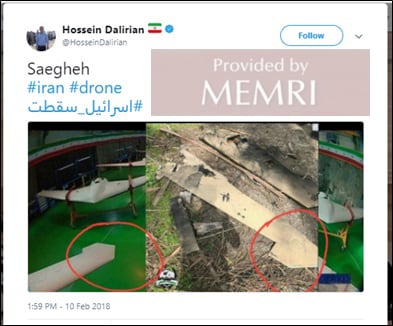
"Segheh; #iran #drone; #Israel has fallen." Twitter.com/HosseinDalirian/status/962400696611082240
[1] Haaretz (Israel), February 10, 2018.
[2] On December 11, 2017, it was reported that Soleimani had spoken by telephone with the commanders of the military wings of Hamas and Palestinian Islamic Jihad, and instructed them to recruit new activists in the West Bank. It was also reported that he had told them that the arming of the West Bank was a top priority for Iranian Leader Khamenei, and that Tehran was ready to help support the Palestinian Islamic resistance forces in all ways. It was further reported that Soleimani had pointed out that the other resistance groups in the region were ready to defend Al-Aqsa mosque. Tasnim, Iran, December 11, 2017; Al-Jarida, Kuwait, December 13, 2017. With regard to visits by Iranian officials and officials from Iran's Shi'ite militias, such as Khamenei associate Ebrahim Raisi and Iraqi Shi'ite militia commander Qais Al-Khazali, see MEMRI Special Dispatch No, 7313, Ebrahim Raisi, Associate And Designated Heir Of Iranian Supreme Leader Khamenei, At Lebanon-Israel Border: "Soon We Will Witness The Liberation Of Jerusalem," February 2, 2018; MEMRI Inquiry and Analysis No. 1366, Intensive Discussions In Resistance Axis Ahead Of Possible Joint Confrontation With Israel; Syrian Daily: A Confrontation Is Inevitable, January 1, 2018; MEMRI TV Clip No. 5745, Iraqi Shiite Militia Commander Qais Al-Khazali Enters Lebanon, Visits Israeli Border, December 8, 2017.
[3] It should be noted that the Iranian drone was reverse-engineered from an American RQ-170 that crashed in Iran; President Obama did not order it destroyed and therefore Iran was able to seize it in its entirety.
[4] Tasnim (Iran), February 10, 2018.
[5] Tasnim (Iran), February 10, 2018.
[6] ISNA (Iran), February 10, 2018. Also on February 10, Iranian President Hassan Rohani warned, in a Tehran speech to foreign ambassadors and representatives several hours after the drone incident: "If a particular country thinks that by strengthening terrorism, foreign intervention, or bombing neighboring [countries] it will be able to obtain desired results, then it is wrong and mistaken. Iran is ready to be more active than in the past in order to instill stability and security... We see today connections among three countries, or among several countries [a reference to the cooperation between Iran, Russia and Turkey regarding Syria] in the region, and we recognize this sort of relationship as beneficial to peace and stability in the region." President.ir/fa, February 10, 2018.
[7] A reference to the downing of a Saudi F-15 over Yemen by pro-Iran Houthi forces in January 2018.
[8] Tasnim (Iran), February 10, 2018.
[9] ISNA (Iran), February 11, 2018.
[10] Mehr (Iran), February 12, 2018.
[11] Twitter.com/HosseinDalirian, February 10, 2018.



